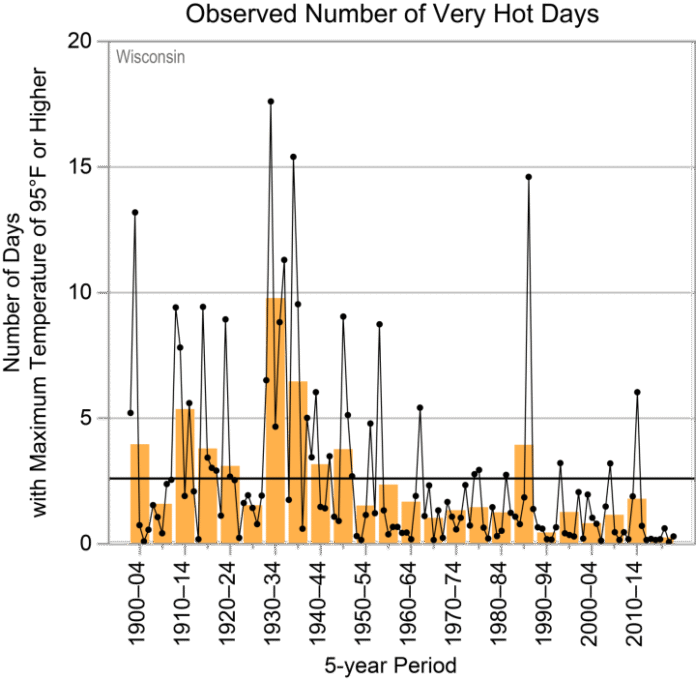By Linnea Lueken
A recent article by the Milwaukee Journal Sentinel (MJS) titled “Extreme heat. Warmer water. More ticks. Fewer fish. Climate change report brings grim news,” claims that the Great Lakes region is suffering from climate change, especially in the realm of extreme heat and unstable lake water levels. This is false. Heat is not becoming more extreme in the Midwest, nor are the Great Lakes’ levels unusual.
The MJS references a climate change report written by the Environmental Law and Policy Center (ELPC), which the paper says “brings grim news.” The ELPC is a renewables-promotion organization, that stands against nuclear, coal, and gas, in favor of wind and solar.
The MJS lists several areas of “grim news,” but for the sake of brevity this Climate Realism post will address just a few of them.
The writer of MJS’s story begins her story by saying that people used to consider the Great Lakes region a “climate haven,” protected from extreme weather. This is obvious nonsense. Thousands of people, seasonal snowbirds included, leave that area for sunny places like Florida and Arizona every winter. The region is famous for its “Lake effect,” blizzards and storms. No place is a climate haven. A previous Climate Realism post debunked the same claim made about Asheville, NC, in the aftermath of devastating hurricane-related floods there in 2024. Extreme weather happens everywhere at some time or another, choosing the Midwest, you get hot summers prone to extreme thunderstorms and tornadoes, and winters with severe snow.
The MJS goes on to say that average temperatures have increased in the Midwest since the 1900s, which is true. However, the MJS misses the fact that this trend is not driven by an increase in very hot days. The MJS claims this is the case, saying “dangerously hot days are happening more often,” but this statement is false. Data from the National Oceanic and Atmospheric Administration shows a decline in the number of days experiencing “very hot” conditions since the early part of the 20th century. That goes for Wisconsin, Illinois, Michigan, Ohio, Indiana, and Iowa. (Figure 1 demonstrating this for Wisconsin, for example)
What is happening is there has been a decline in the number of “very cold” days, or days with maximum temperatures of 0°F or lower.
Additionally, nighttime temperatures are trending upwards on average, which the study and MJS admit but misunderstand and ignore the importance of this fact. MJS says higher temperatures both day and night occur “especially in urban heat islands where surfaces like parking lots, sidewalks and streets absorb and hold onto heat.” But that is not a small concession, rather that is the a fundamental point. It is mostly nighttime temperatures that are influenced by UHI, as discussed in detail by meteorologist Anthony Watts over at Climate at a Glance, here.
Oddly, MJS also claims “another alarming trend given extreme nighttime heat can actually be deadlier than daytime heat.” The MJS presents no evidence this is true, because there is none. More importantly it misses a larger point. Cold temperatures are deadlier than heat. If nighttime lows are trending upwards, this should save lives on balance.
Citing the report, MJS also claims that climate change is causing “greater fluctuations in lake levels” and that overall, water levels are rising. This is ironic, in 2013, climate alarmists warned warn that computer models forecasts that Great Lakes would gradually lose water from climate change. And in 2024, the Washington Post warned again of falling Great Lakes water levels. Now, alarmists claim that water levels are rising in general but also see-sawing unnaturally. The truth is there is no consistent trend in water levels on the Great Lakes, nor are they waxing and waning in an unusual fashion. Throughout the limited “official” record of Great Lakes water levels, data show water levels have always varied widely over time.
As a final note, the authors of the study the MJS reports on, the ELPC, released a similar report in 2019. This one predicted that corn and soybean production would crash by mid-century. Since then, as a brief illustration on how flawed the models used by the study’s authors are, Wisconsin corn yields hit an all time high two years running in 2021 and 2022.
The MJS and the ELPC are interested in promoting climate alarmism, they are not interested in accurately reporting the unalarming truth about the Great Lakes region, a truth grounded in hard data that shows no trends in worsening weather or climate induced harms to people in the region. The MJS story is simply bad journalism, and the report it builds its misleading story around isn’t science at all, rather it is propaganda meant to promote a net-zero fossil fuel agenda, favoring the wider forced adoption of ever more wind and solar energy.
Related
Discover more from Watts Up With That?
Subscribe to get the latest posts sent to your email.
